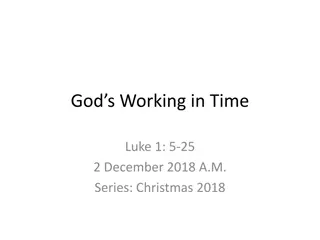
Integrating Unpaid Household Services into Consumer Expenditure Surveys
Explore the research efforts in integrating unpaid household services into consumer expenditure surveys to provide a more comprehensive understanding of household consumption. The study aims to address the lack of data on the contribution of unpaid services to household consumption, using a synthetic data set to estimate their value. Recommendations for future work and data sources are also discussed.
Download Presentation

Please find below an Image/Link to download the presentation.
The content on the website is provided AS IS for your information and personal use only. It may not be sold, licensed, or shared on other websites without obtaining consent from the author. If you encounter any issues during the download, it is possible that the publisher has removed the file from their server.
You are allowed to download the files provided on this website for personal or commercial use, subject to the condition that they are used lawfully. All files are the property of their respective owners.
The content on the website is provided AS IS for your information and personal use only. It may not be sold, licensed, or shared on other websites without obtaining consent from the author.
E N D
Presentation Transcript
Home production and expenditures: Substitutes, complements, or both? A prototype for integrating time use and household expenditure surveys By Ajit Zacharias, Fernando Rios-Avila, Nancy Folbre, Tom Masterson and Jake Schild IARIW General Conference, Session 2D-2 London, August 26-30, 2024 Discussant: Jorrit Zwijnenburg (OECD) Unclassified - Non classifi
Topic of the paper Main issue: Unpaid household services are an important component of total consumption However, results are lacking, partly as a result of inadequate input data The main aim of the work is to address this issue, by developing a synthetic data set to provide estimates of the contribution of unpaid services to household consumption Work has been conducted by a research team at the Levy Economics Institute of Bard College commissioned by the US Bureau of Labor Statistics, with the aim to develop a more complete picture of household consumption More details in report Integrating Nonmarket Consumption into the Bureau of Labour Statistics Consumer Expenditure Survey The paper also includes recommendations for future work Unclassified - Non classifi
Approach A similar approach is applied as used for extended household income (i.e., market income + imputed value of unpaid household work, based on replacement cost approach) This approach is consistent with national accounts principles Different from utility measures (including value of leisure time) and opportunity cost approach It comes down to estimating the value of unpaid household services consumed by households and adding it up to market consumption. This requires information on: Market consumption Time spent on unpaid household service work by households The value/price of these services The part that is not consumed by the household itself Additional unpaid household services as received from other households Unclassified - Non classifi
Data sources Consumer Expenditure Interview Survey (CE) Collects data on spending, demographics and other financial information Provides the basic information for expenditure data ( market consumption ) American Time Use Survey (ATUS) Collects data on time spent on various activities, location and presence of others Provides input on time spent on unpaid service activities (including supervisory care) Early Childhood Program Participation Survey (ECPP) Collects data on regular care received by children under 6 not enrolled in kindergarten Provides input on childcare received from outside the household Health and Retirement Survey (HRS) Collects data on amount of care time received by people over 50 with health problems or disabilities Provides input on elderly care received from outside the household Information on hourly wages (not explicity mentioned in the paper) Provides input on replacement cost/price for each of the categories Unclassified - Non classifi
Definitions Definition of household production Defined as suitable for a broad consumption measure at the household level , so including services received by the household and excluding services provided other households Unpaid household services are defined on the basis of the third-party principle, i.e., those services that can theoretically be delegated to a paid provider or purchased in the market Categories are determined in line with the 2019 ATUS: Cooking Housework (except cooking) Shopping Care of household adults Care of household children Unclassified - Non classifi
Time spent Time spent on various activities is taken from ATUS A specific issue revolves around supervisory care, as this may not always be properly captured in time use surveys ATUS includes several questions regarding time spent with children under 13 in your care which may provide a reasonable proxy To avoid double counting, they partially discount time when another adult was present They also apply a different value for supervisory care compared to active care Unclassified - Non classifi
Replacement cost Replacement costs are based on specialist wages rather than the generalist wage method as applied by the U.S. BEA Different hourly wage rates are applied to different categories Cooking: Average wage of cooks, excluding chefs Active childcare: Mean combined hourly wage for preschool and kindergarten teachers (both excluding special education) Supervisory care: 0.5 of active childcare Elderly care: Average wage of nursing assistants Household work (other than cooking) and shopping: Not specified in the paper Wages are differentiated by geographic division Unclassified - Non classifi
Linking data across the different data sets As data is used from different data sources, the information needs to be linked to construct datasets that include all relevant information: Constrained statistical matching is applied to impute time use (from the ATUS) for respondents of the Consumer Expenditure Survey (CE) A regression prediction with noise is used to impute data from the Early Childhood Program Participation Survey and the Health and Retirement Survey for respondents of the CE for childcare and elderly care received from outside the household Unclassified - Non classifi
Results Unclassified - Non classifi
Analyses of the results Divergence with BEA results is largest for households with children This is mainly driven by the valuation of supervisory care which is not included in the BEA approach and accounts for a large share of unpaid activities Unclassified - Non classifi
Analyses of the results The addition of unpaid services increases total expenditures by 63% on average Higher increases for households with children (99% vs. 42%) Men spend about 40% less time on home production than women Women provide 78% of total hours on home production Men spend 52% less time on supervisory care than women Average value of home production varies by race/ethnicity Unclassified - Non classifi
Agenda for future research Refine methodology, also comparing and calibrating with other approaches Explore development of new survey instruments Address three major theoretical issues: 1. Equivalence scales to reflect consumption needs of households of different size and composition: These may need to change when including unpaid household services Substitutability between purchased and own-produced services: This may be limited for certain categories (e.g., active childcare) Potential for technological change in household production: How to account for potential productivity gains 2. 3. Unclassified - Non classifi
Discussion It concerns a very important topic for which there is a lot of policy demand The paper highlights the main complexities in deriving measures of unpaid household work How to obtain good quality information on time spent on different types of unpaid household activities? How to determine the wage costs as input for the replacement cost approach? How to link the data across different data sources? The methodology is broadly in line with the SNA approach (see ISWGNA, 2024) However, a couple of differences: 1. The categories are more limited than as proposed in the ISWGNA Guidance Note: ) Childcare, 2) adult care, 3) nutrition, 4) transport, 5) household management services (e.g., cleaning, administration, gardening), 6) laundry and clothing services, 7) shopping, 8) information services, and 9) volunteering [underlined match] Unclassified - Non classifi
Discussion 2. It only focuses on labour component and does not address capital component (e.g., use of consumer durables in production of unpaid services); much smaller (around 2.2% of GDP for U.S. in Van de Ven, Zwijnenburg and De Queljoe (2018)) but still relevant 3. Some final market consumption will feed into value of unpaid household services (e.g., purchases of ingredients for meals as input to nutrition services). This will not affect total consumption, but may lead to more accurate measures of consumption items Interesting how you have approached the inclusion of supervisory care, managing to avoid double counting and finding a way to derive an appropriate price level Agenda for future research includes relevant topics. For some, it will be interesting to see what elements they may affect (e.g., substitutability) Do you also foresee the need to further improve (some of) the input data? We are planning to develop practical guidance to follow-up on the conceptual ISWGNA guidance and will definitely take your work on board Unclassified - Non classifi
Some questions Why did you develop a definition of household production and how do you look upon the exclusion of services provided to other households and inclusion of services received from other households? How do you look upon the cost of capital? Do you feel that these should be included in your estimates? How do you look upon items that become intermediate costs in unpaid household services? Do you see possibilities to expand the categories of unpaid services? How will issues with substitutability affect the results? Will it lead to a different price for specific categories or is it more a matter of utility? How do you look upon the robustness of the time use data? Are you planning to compile time series? Does supervisory care also lead to less efficient primary activity? Unclassified - Non classifi
THANK YOU For more information please contact: Jorrit.Zwijnenburg@oecd.org @OECD_Stat www.oecd.org/sdd www.stats.oecd.org Unclassified - Non classifi



















